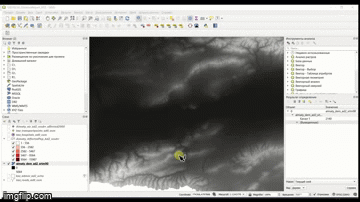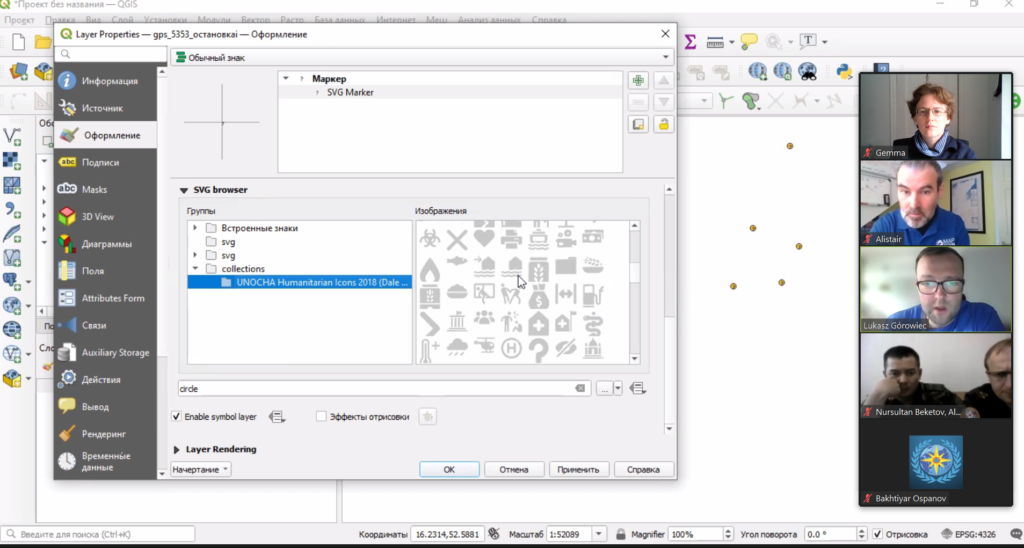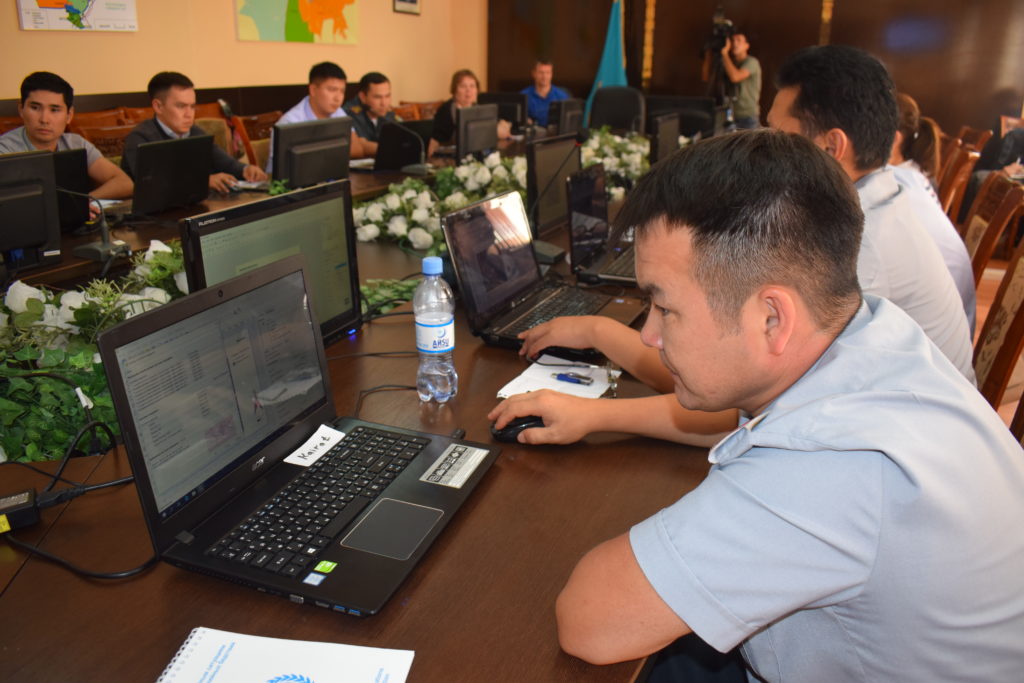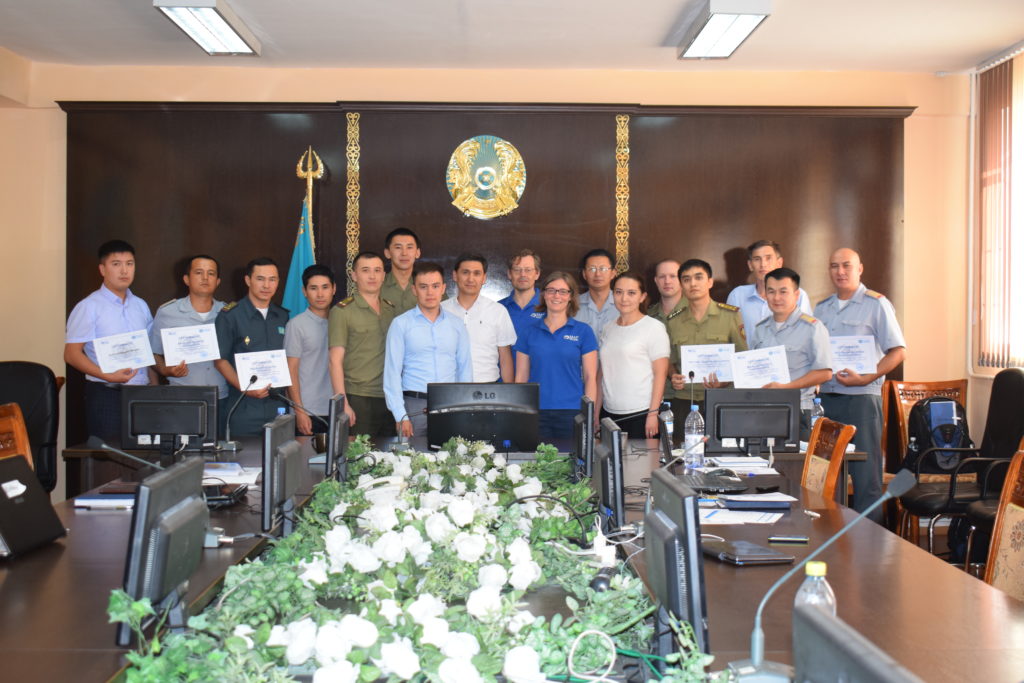MapAction has delivered 15 workshops to disaster managers in Central Asia in the last five years in partnership with the Center for Emergency Situations and Disaster Risk Reduction (CESDRR). Widespread use of GIS and humanitarian information management tools means local disaster managers are evermore prepared for present and future hazards.
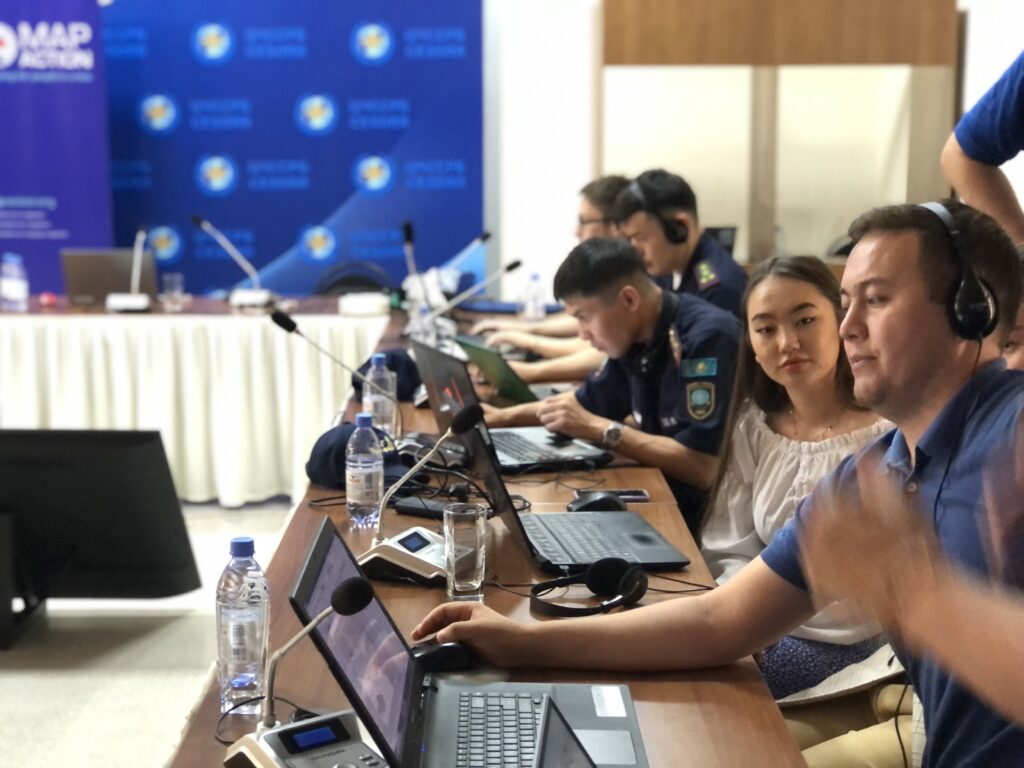
When a fire broke out in a “large” warehouse last year in Almaty, Kazakhstan’s largest urban center, Dusyembaev Bagdat, the officer on duty at the time in the Department of Emergency Situations for the city, didn’t panic.
“I drew a map of the scene using QGIS, indicating the distance from the nearest fire station to the place of the fire,” says Bagdat, 34, recalling how he was able to deploy the mapping skills he had acquired during MapAction co-led workshops with the regional Center for Emergency Situations and Disaster Risk Reduction (CESDRR). Maps like these help decision-makers fast track solutions in crises situations; those decisions can then dramatically reduce human suffering, economic losses and environmental or social risks.
READ ALSO : How maps can save lives when disasters strike
Bagdat had previously attended two MapAction workshops on mapping for emergencies: one in the Kazakh capital Astana in 2022 and another in the former capital Almaty in 2023. These professional development seminars were part of more than half a decade of cooperation between MapAction and CESDRR.
In 2016, Kazakhstan and Kyrgyzstan established the Center for Emergency Situations and Disaster Risk Reduction (CESDRR), headquartered in Almaty, Kazakhstan. The organisation’s objective is to “ensure effective mechanisms to decrease the risk of emergencies, to mitigate the consequences, to organise a joint response.” In order to further strengthen regional cooperation, CESDRR established the Central Asian regional high-level dialogue platform for DRR — the Regional Forum-Meeting of the Heads of Emergency Authorities of Central Asian countries, adding Uzbekistan, Tajikistan and Turkmenistan to the framework. In 2018, MapAction and CESDRR signed an agreement to work together.
The agreement envisaged, among other clauses, an “exchange of technical information, including samples and standards,” as well as “technical assistance,” and support in “professional development” for representatives from member states.
READ ALSO: MapAction Data Science Lab: the story so far
Since then, MapAction has continued to provide support “in GIS and mapping in emergencies.” Nearly six years and more than a dozen key encounters later, the impact is multifold.
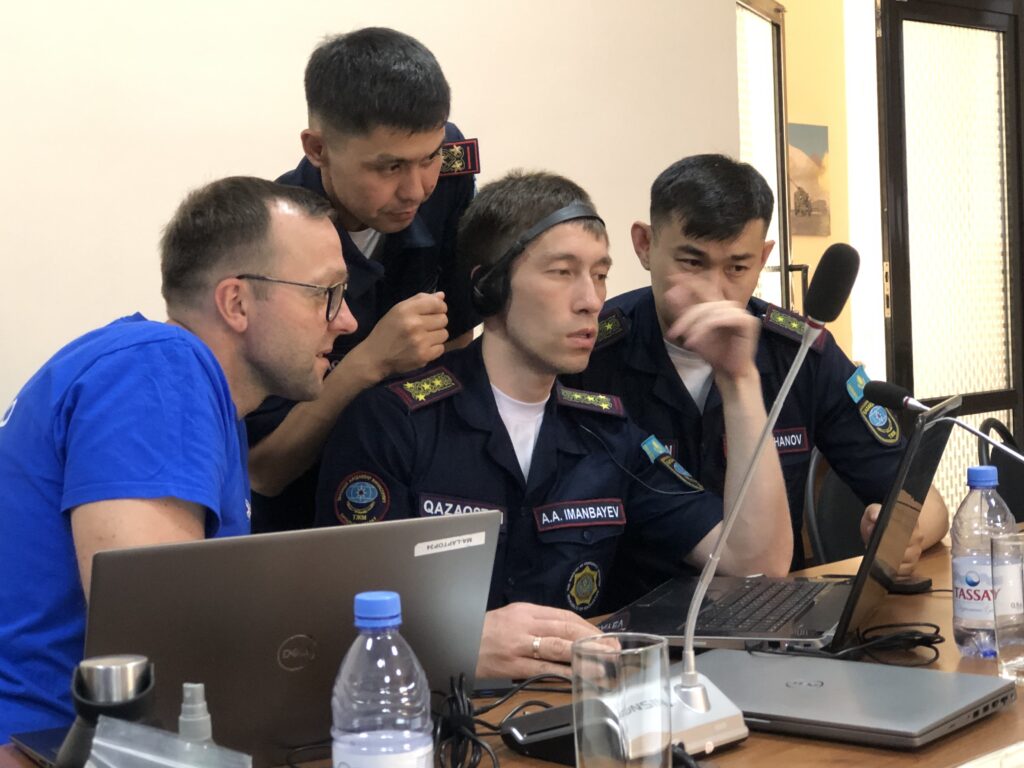
“Real outcomes of our work”
“Today we see real outcomes of our work” says Bakhtiyar Ospanov, a senior expert with CESDRR. “We have been cooperating with MapAction since 2018 and during this period of time we have conducted 15 training courses, trained 320 officers of emergency authorities of Kazakhstan, Kyrgyzstan and Uzbekistan,” Ospanov told MapAction. Nearly a dozen MapAction staff members and volunteers have been involved in organising seminars on humanitarian information management and mapping for/in emergencies during the 60-month+ engagement.
The impact is mushrooming. Many of the disaster managers seconded by their organisations in the past to learn GIS tools and practices for humanitarian response have since become trainers in their own right, passing on what they learned to colleagues. This domino effect has created a cohort of GIS-savvy disaster managers in the region.
They face no shortage of challenges. “Central Asia is an extremely disaster-prone region, suffering annually from the consequences of natural disasters. In addition to earthquakes, the region is constantly threatened by landslides, floods, mudflows, droughts, avalanches and extreme air temperatures,” noted Minister of Emergency Situations of the Kyrgyz Republic Major General Azhikeev Boobek at a regional summit in late 2023. In Kazakhstan alone, on average “3,000-4,000 emergency situations happen annually with 3,000-5,000 thousand victims” states UNICEF in a recent report on disaster resilience. Fires continue to be a major hazard in the Kazakh Steppe, a large area of natural grassland.
Fighting fires with GIS
Mapping solutions is key. “There is a group of officers who improved their skills and knowledge at MapAction’s last training in Almaty (June 2023) and who are about to become national trainers,” CESDRR’s Bakhtiyar Ospanov, who works alongside six other staff members at CESDRR’s HQ, told MapAction by email.
PODCAST: Towards disaster resilience with CDEMA in the Caribbean
Bagdat, who helped map a solution to extinguish the fire at the warehouse in Almaty, is one of them. He now trains other members of his team of 10 who all work in the disaster management department for Kazakhstan’s largest city, and former capital, Almaty. Some of the maps created support search and rescue operations. Others can help identify a solution in a dangerous situation.
Bakhtiyar from CESDRR shared with MapAction three sample maps, made to strengthen disaster preparedness, created by reps from member states who attended MapAction’s humanitarian mapping seminars in recent years.
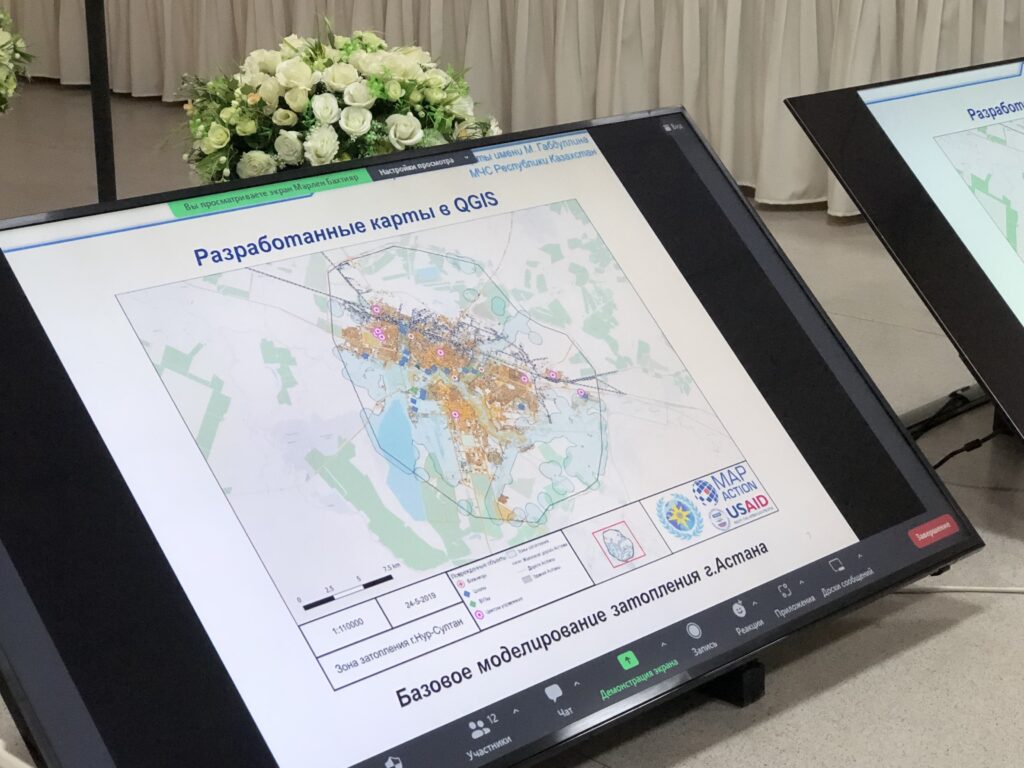
One envisages key scenarios in the event of an earthquake striking Almaty; another shows the location of the rescue helicopters of the Kazakhstan Air Rescue Service, by province/oblast. Yet another envisages a potential situation in the area around the Kapchagay Reservoir – just north of Almaty – should its dam be damaged/broken.
Maps for such emergencies – even if only simulated – always seek to mitigate risks.
Domino GIS effect
“What is very important is that after the training our specialists are able to share their knowledge and teach new employees,” Zaginaev Vitalii, 36, a former division head in the hazard monitoring and forecasting department at the Ministry of Emergency Situations of the Republic of Kyrgyzstan, tells MapAction. “I shared the knowledge gained (ed: from MapAction workshops) with my colleagues. Now they also know how to work on this program (Ed: QGIS – free mapping software). We use this program in the case of large fires or emergencies where there are victims or casualties. Also, during various search and rescue or emergency rescue operations, we use the QGIS program for a visual concept of the location of an emergency or incident,” Vitalii, who is now applying his experience in the academic sector, told MapAction.
Less than a decade old, CESDRR still has big plans. While the intergovernmental organisation does not do emergency response per se and essentially “is a bridge between Central Asian national disaster agencies and the international community,” as per Bakhtiyar, the team is equipped with drones and operators as well as UAVs “and can be involved in transboundary or resonant disaster rescue.”
Looking ahead, Bakhtiyar from CESDRR says a shared digital atlas of hazards is on the horizon for CESDRR members, inviting MapAction to take a key partner role for that future initiative. Long may the partnership live.
“We look forward to continuing to build the strong relationship we have with CESDRR to further strengthen disaster preparedness in the Central Asian region through the provision of more GIS and humanitarian IM support,” says MapAction’s CEO Colin Rogers.
READ ALSO: MapAction excited to announce Colin Rogers as new Chief Executive
Central Asian risk atlas
There is work to be done still. “In Central Asia, there is no unified geographic information system that includes a digital atlas of natural and man-made transboundary hazards and reflects basic data on existing risks,” says Ospanov.
“The development of a unified geographic information system reflecting interactive maps of the Central Asian countries and applying information on existing risks in the form of blocks (layers) on them will make it possible to provide the subjects of emergency situations with reliable information about potential sources of emergency situations and the causes of their occurrence, ensuring control over the state of sources of emergency situations, early forecasting of possible emergency situations and their management,” says Ospanov.
Bakhtiyar’s comments point to an increasing emphasis on anticipatory action. A fire extinguisher puts out fires; a fire alarm helps prevent them. Preparedness is key.
All of MapAction’s work in supporting CESDRR has been funded by USAID’s Bureau for Humanitarian Assistance (BHA).
WATCH MORE: Animated video about what we do at MapAction

